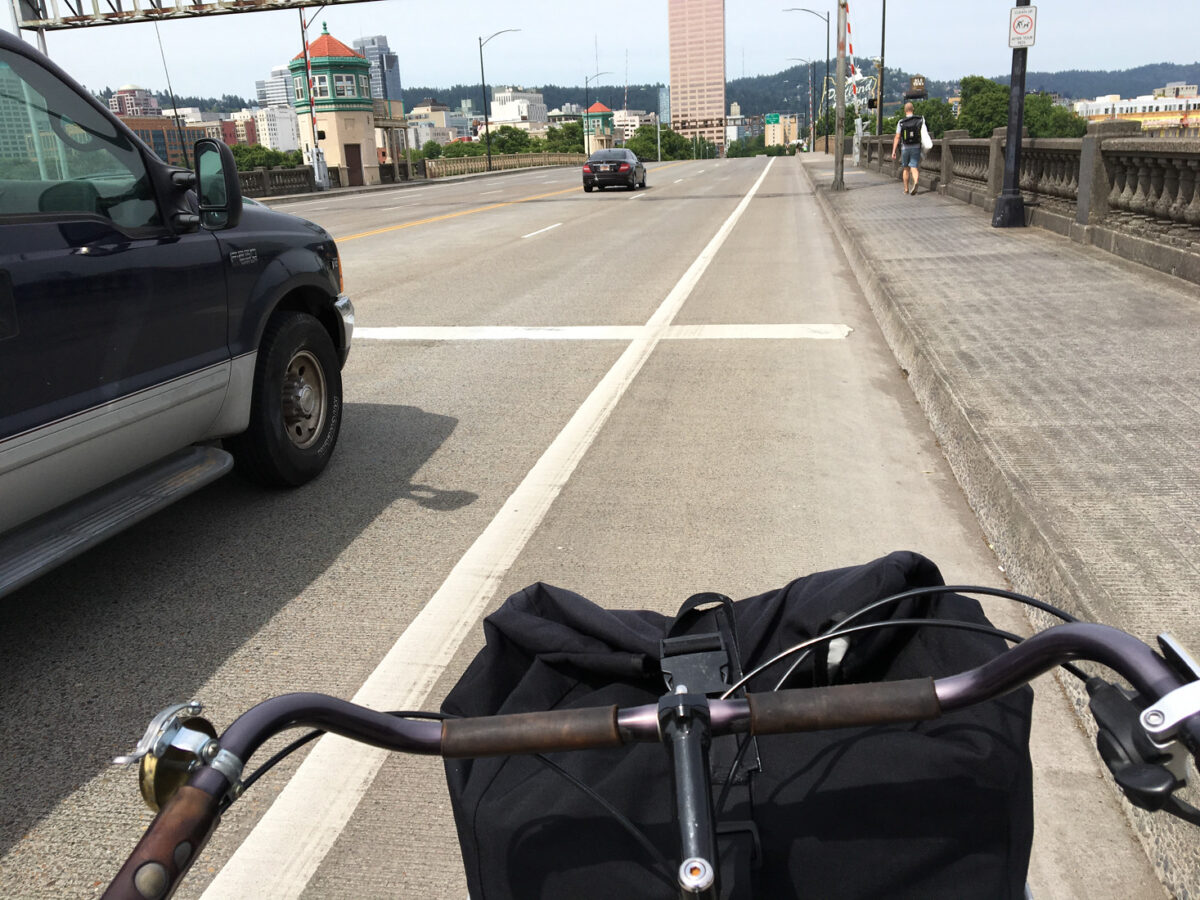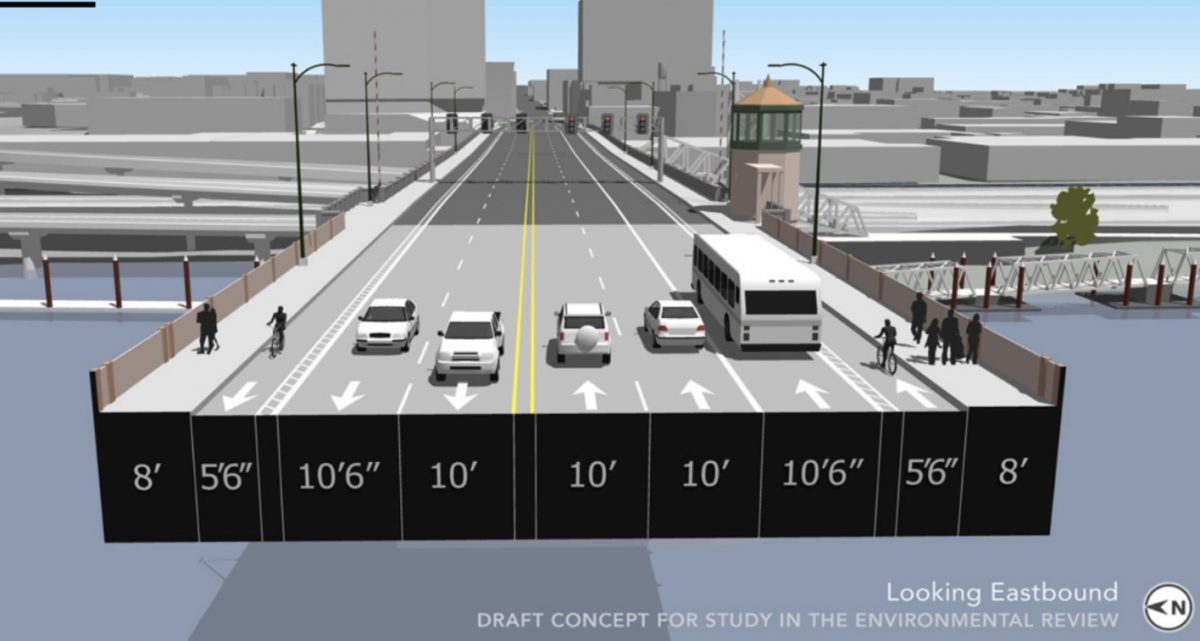
(Photo: J. Maus/BikePortland)
“Advocates… let us know how important it is to do something more soon to separate bicyclists from traffic on the bridge.”
— Mike Pullen, Multnomah County
If you attended the annual Alice Awards fundraiser hosted by The Street Trust last month, you heard the event’s emcee, Multnomah County Commissioner Jessica Vega Pederson, break some good news: When the Burnside Bridge fully re-opens after a maintenance project wraps up later this year its bike lanes will be wider and be separated with plastic wands.
“Three months ago, The Street Trust and other advocates learned that Multnomah County did not intend to provide physical protection for bike lanes until the Burnside Bridge is replaced,” the organization shared on their website this week. “The Street Trust banded together with Bike Loud and Better Block PDX to demand protected bike lanes now.”

For years, Portlanders have pushed to have more protected* cycling space on the Burnside Bridge. In 2012 I joined a team of planners to propose a two-way protected lane on the bridge for bicycle users. In 2015, when a man lost control of his SUV and killed someone (and seriously injured another person) who was walking on the bridge sidewalk, I said “enough is enough” and called on the City and County to do something. After that tragedy we shared possible design changes that would create space for a wider, protected bike lane. In 2016, Better Block planned a demonstration project that would have included physically protected bike lanes on the bridge. That demo never happened, but support for the concept never waned.
Now, with a County maintenance project on the bridge due to end in November and with the City of Portland’s Central City in Motion (CCIM) project all queued up, it appears that
a breakthrough has finally occurred.
This outcome was never guaranteed. At least not for another 10 years. It happened because Portland advocates stepped up to push the issue forward.
Advertisement

(Graphic: Multnomah County)
Multnomah County plans to replace this bridge with a more earthquake-ready version several years from now. That new bridge will almost certainly come with serious bike lane protection such as a concrete jersey barrier. But what about the period between now and whenever that bridge is built?

The County owns and manages the bridge, but they work with PBOT to decide how the lanes are striped. In this case the County worked with PBOT’s CCIM project team to narrow existing lanes in order to create two-foot wide bike lane buffer zones between bicycle and car users. PBOT plans (PDF) show only a painted buffer and no physical separators of any kind. Even the PBOT project website says this new striping plan offers only, “the possibility of providing protected bike lanes.”
When The Street Trust Executive Director Jillian Detweiler started to sniff around this situation a few months, she sensed resistance to protected bike lanes from County project staff. One reason the County might have been reluctant is because their sweepers can’t fit into narrow bike lanes that have physical separation. Not satisfied with excuses she was hearing, Detweiler reached out to other advocates and set up meetings with the County and with the City of Portland.
According to Detweiler, County Transportation Director Ian Cannon wasn’t willing to add physical protection and tried to persuade the advocates to wait for the new bridge. That’s when she contacted Commissioner Vega Pederson and convinced her to support the proposal.
Multnomah County spokesperson Mike Pullen confirmed with us today that the Commissioner made her support of the protected lanes known and that the advocates, “Let us know how important it is to bicyclists to do something more soon to separate bicyclists from traffic on the bridge.”
Pullen now says white “candlestick” delineator wands will be added in the new buffer zone. “While these won’t stop a motor vehicle, they do give drivers a clearer view of the buffer zone, especially at night and in bad weather,” he said.
The wands will be installed in the next two months. And if you’re concerned about debris in the bike lanes, Pullen said they plan to draft a maintenance agreement with PBOT (who just added another tiny sweeper to their fleet). We’ve asked PBOT for an update on their CCIM bus lane/bike lane project on the bridge and will update this post when we hear back.
For now, I want to say “Thank you!” to Jillian, Emily Guise from Bike Loud, and Ryan Hashagen from Better Block. Your diplomacy skills and passion for safer bikeways really made a difference!
(*NOTE, 10/17 at 8:10 am: There’s an ongoing discussion about whether or not plastic wands constitute real “protection”. Some readers have questioned my use of that word and feel it gives too much value to what are nothing more than weak pieces of plastic that don’t provide quality, physical protection from multi-ton vehicles. I’m still thinking about the best way to describe our various types of bike lanes and the amount of true “protection” they provide. I take word choices very seriously and will continue to evolve my thinking on this specific usage. Thanks for the feedback.)
— Jonathan Maus: (503) 706-8804, @jonathan_maus on Twitter and jonathan@bikeportland.org
— Get our headlines delivered to your inbox.
— Support this independent community media outlet with a one-time contribution or monthly subscription.

